Although it has been the premier public course in the midwest for the last 20 years, I’d never really had a burning desire to play the Straits Course at Whistling Straits. The main reason was that it was incredibly expensive. But I also got to see it plenty of times on TV and between that and playing Arcadia Bluffs—Michigan’s equivalent—several times over the years, I almost felt like I had already seen it. These are some of the same reasons why Pebble Beach isn’t too high on my list.
But one thing that I’ve come to believe, maybe as a result of now being an independent adult and having the money to do it, is that for something you really want, or maybe even just something that you feel that you should do for completion’s sake, you should spend the money. I’ve become much happier to spend a good amount of money to play a course that I really want to play because it creates a lot of memories. I’m good about remembering details of courses, plus I take comprehensive pictures. So I get a lot that’s lasting out of it. And if you think about it, $350 for a round of golf is only ~$80 and hour, the price of a golf lesson. I’ll remember much more of this.
And actually, Whistling Straits was something of a deal in $/hr…because it took 5 1/2 hours to play. Our group was something of a small army on the first tee; four players, two wives, and two caddies. It was only my second time taking a caddie and…my second time learning why I never take a caddie. They double bag here and if the guy playing from the other bag is terrible, you’re gonna feel by the end of the round that the caddie should tip you for all the running back-and-forth that you’ll have to do. And for some reason, despite the fact that they’re shooting 125, people seem to treat every shot here like they’re a pro, trying to get distances to every one of the 1000+ bunkers, reading each putt from 7 angles. There was no one in front of us, we had six hours of sunlight, yet we barely made it. It was excruciating.
But back to the course itself. As mentioned, I felt pretty familiar with it having seen it so many times on TV. But there were a few surprises, some good, some bad. The first concern I had was that all of them being next to the water, the par 3s would feel too similar. That wasn’t an issue because they vary in elevation change and distance. The other was that the figure-8 routing would create paired holes that felt too similar to each other. Also not really an issue. 8/13 have a somewhat similar feel but 8 is much longer, so they didn’t feel too similar. Actually the par 5s 2/16 felt the most similar, but they aren’t in the same place in the routing.
The one thing that’s really an issue here is how narrow the fairways have become. They narrowed them for the PGA many years ago and I’m pretty sure they’re not extending them back. Some of the corridors of the holes along the coast also felt a bit too narrow and left me feeling that these holes might be impossible in a good wind. Finally, there’s one truly awful hole, no. 5, and a few greens that are completely overdone.
I mentioned that part of the reason that I didn’t have a burning desire to play here was that I had played Michigan’s equivalent, Arcadia Bluffs several times. How do they stack up? Actually, Arcadia Bluffs stacks up pretty well. It’s far less walkable, which is a real weakness, and it doesn’t have as many really good holes. But there’s more variety in the shaping of the holes at Arcadia Bluffs. I also preferred the greens there, which are heavily contoured but aren’t in so many awkward shapes. Arcadia only has a few cliffside holes but many of the inland holes are quite good. It’s a clear win for Whistling Straits, but the difference between them is not as big as the lists suggest…and closer to what I suspected.
Although it was some three weeks after the Ryder Cup, a lot of the stands were still up, including the one walking to the first tee. Walking through that was pretty cool.
The opening tees were up about 40 yards making this a short par 4 of ~360. Bryson may be able to drive the green but the rest of us should be focused on the bunker complex that narrows the fairway on the right at about 230. I went with driver in my first round and skirted the edge, leaving a wedge down the angle of the green. In my second round, I laid back and had an 8-iron. Unless you can get past the bunker, the green is very shallow, too shallow even for an 8-iron. I’d need a few more rounds to say for sure, but I think it’s best to take on the risk from the tee here.
But one thing that I’ve come to believe, maybe as a result of now being an independent adult and having the money to do it, is that for something you really want, or maybe even just something that you feel that you should do for completion’s sake, you should spend the money. I’ve become much happier to spend a good amount of money to play a course that I really want to play because it creates a lot of memories. I’m good about remembering details of courses, plus I take comprehensive pictures. So I get a lot that’s lasting out of it. And if you think about it, $350 for a round of golf is only ~$80 and hour, the price of a golf lesson. I’ll remember much more of this.
And actually, Whistling Straits was something of a deal in $/hr…because it took 5 1/2 hours to play. Our group was something of a small army on the first tee; four players, two wives, and two caddies. It was only my second time taking a caddie and…my second time learning why I never take a caddie. They double bag here and if the guy playing from the other bag is terrible, you’re gonna feel by the end of the round that the caddie should tip you for all the running back-and-forth that you’ll have to do. And for some reason, despite the fact that they’re shooting 125, people seem to treat every shot here like they’re a pro, trying to get distances to every one of the 1000+ bunkers, reading each putt from 7 angles. There was no one in front of us, we had six hours of sunlight, yet we barely made it. It was excruciating.
But back to the course itself. As mentioned, I felt pretty familiar with it having seen it so many times on TV. But there were a few surprises, some good, some bad. The first concern I had was that all of them being next to the water, the par 3s would feel too similar. That wasn’t an issue because they vary in elevation change and distance. The other was that the figure-8 routing would create paired holes that felt too similar to each other. Also not really an issue. 8/13 have a somewhat similar feel but 8 is much longer, so they didn’t feel too similar. Actually the par 5s 2/16 felt the most similar, but they aren’t in the same place in the routing.
The one thing that’s really an issue here is how narrow the fairways have become. They narrowed them for the PGA many years ago and I’m pretty sure they’re not extending them back. Some of the corridors of the holes along the coast also felt a bit too narrow and left me feeling that these holes might be impossible in a good wind. Finally, there’s one truly awful hole, no. 5, and a few greens that are completely overdone.
I mentioned that part of the reason that I didn’t have a burning desire to play here was that I had played Michigan’s equivalent, Arcadia Bluffs several times. How do they stack up? Actually, Arcadia Bluffs stacks up pretty well. It’s far less walkable, which is a real weakness, and it doesn’t have as many really good holes. But there’s more variety in the shaping of the holes at Arcadia Bluffs. I also preferred the greens there, which are heavily contoured but aren’t in so many awkward shapes. Arcadia only has a few cliffside holes but many of the inland holes are quite good. It’s a clear win for Whistling Straits, but the difference between them is not as big as the lists suggest…and closer to what I suspected.
Although it was some three weeks after the Ryder Cup, a lot of the stands were still up, including the one walking to the first tee. Walking through that was pretty cool.
The opening tees were up about 40 yards making this a short par 4 of ~360. Bryson may be able to drive the green but the rest of us should be focused on the bunker complex that narrows the fairway on the right at about 230. I went with driver in my first round and skirted the edge, leaving a wedge down the angle of the green. In my second round, I laid back and had an 8-iron. Unless you can get past the bunker, the green is very shallow, too shallow even for an 8-iron. I’d need a few more rounds to say for sure, but I think it’s best to take on the risk from the tee here.
The second is a par 5 of about 520 from the regular back tees. This was one of several holes where the fairway felt a bit awkwardly narrow. You need to carry about 260 here to clear the narrow area, which has bunkers and bushes on both sides.
The fairway jogs right in the layup area about 100 yards short of the green and you’ll need to decide whether you’re laying up, which leaves a partially obstructed view into the green or going for the sliver of fairway short of the green. If going for the green, there’s a nasty bunker about 20 yards short that you’ll have to avoid. The green is a beauty, both in view and contours.
Three is the course’s medium-length par 3 and it’s a good one. It plays a good one club down hill although you need to make sure that you carry it into the green because there’s a false front.
The long par 4 fourth also seemed awkwardly narrow, especially from the tee because you can’t see much of the fairway. Aim just inside the bunkers on the hill on the right, which are ~250 out. Long hitters need to aim a bit further left and the rest of us will ideally hit a draw because if you can get it past this, the fairway runs down hill to the left, cutting about 30 yards off the approach. The approach is a great one, with plenty of room to run the ball in from the right and a good chance of a favorable kick. Great hole.
The fifth is not a great hole. In fact, it’s one of the worst holes that I’ve ever played. I’m sure that everyone now tries to carry the pond like Bryson did. You can’t do it and shouldn’t try.
But you do need a long ball and should try to hug the pond because unless you get to the end of the fairway, the landing area for the second is completely blind. This second shot is probably one of the ten or so worst shots I’ve seen on a golf course. The fairway angles to the right and the whole thing is carry over bunkers, but it’s hard to tell how far you need to hit it and where the fairway on the right ends. The pond angles in on the left, but it’s hard to tell where that is too. I was amazed to see pros laying up into the water during the Ryder Cup but having played the hole now, I’m not surprised.
But you do need a long ball and should try to hug the pond because unless you get to the end of the fairway, the landing area for the second is completely blind. This second shot is probably one of the ten or so worst shots I’ve seen on a golf course. The fairway angles to the right and the whole thing is carry over bunkers, but it’s hard to tell how far you need to hit it and where the fairway on the right ends. The pond angles in on the left, but it’s hard to tell where that is too. I was amazed to see pros laying up into the water during the Ryder Cup but having played the hole now, I’m not surprised.
To me, a simple fix would be to remove the mounds around the bunkering on the right so that you could see the fairway. It would still be an awkward hole that stylistically has no place on this course, but it wouldn’t be such a disaster. Apparently they’re going to completely redo it though, which is probably even better.
The ~360 yard par 4 sixth also created a lot of drama in the Ryder Cup, with many pros trying to drive the green. But this was another hole that I didn’t like. The main problem is the hourglass-shaped green. If the pin is on the right, it’s simply too small for anyone but the pros to hit with anything more than a sand wedge. There’s no bailout area where you can be pretty sure that you won’t go back-and-forth across the green. And unless you drive it 250+ or way left (in the rough), you can’t really see this part of the green. So it’s a short par 4 that demands a long drive and has nowhere to play safe if you don’t pull that off.
I think that I would like the hole much more with the pin on the left (both times I played it was on the right), which makes it much easier. But I don’t see the problem with that as we just played two very hard holes and have several more to come.
The ~360 yard par 4 sixth also created a lot of drama in the Ryder Cup, with many pros trying to drive the green. But this was another hole that I didn’t like. The main problem is the hourglass-shaped green. If the pin is on the right, it’s simply too small for anyone but the pros to hit with anything more than a sand wedge. There’s no bailout area where you can be pretty sure that you won’t go back-and-forth across the green. And unless you drive it 250+ or way left (in the rough), you can’t really see this part of the green. So it’s a short par 4 that demands a long drive and has nowhere to play safe if you don’t pull that off.
I think that I would like the hole much more with the pin on the left (both times I played it was on the right), which makes it much easier. But I don’t see the problem with that as we just played two very hard holes and have several more to come.

I think that this back-right section is too small and there's just nowhere safe to miss. I hedged long-left and that's where I missed...and then I chipped off the front of the green! I'd lose this right half and taper the left side of the green off to its back-right, leaving some tough hole locations there.
Down on the water’s edge, the par 3 seventh requires a much longer iron and looks intimidating, but I found it much easier. There’s fairway short and left but the big help here is that you can hit a pretty good pull and the ball will still kick off the mounds onto the green.
Eight is a stunning long par 4. If you hit the ball in the 260 range like I do, it’s actually best to got to the 450 yard standard back tees (~7,100 yards) because you can run out of fairway on the right from the 415 yard green tees (~6,450 yards). There is room to the left if you carry some of the bunkers up the left side of the fairway. The green is large and there’s room to run it on, but you’ll need to be pretty accurate.
Playing into a funnel-shaped fairway, the par 4 ninth is one of the least-intimidating driving holes. But the approach makes up for it. Like six when the pin is on the right, you need a long drive here because the green is small.
Ten is another shortish par 4 where they moved the tees up in the Ryder Cup to make it drivable. It’s a tough hole from the standard back tees unless you can make the 240 carry to the ridge in the fairway. If you can, the fairway is quite wide. Like one, the green is narrow but deep.
Eleven is an excellent par 5, but a bit awkward. This is another hole where the drive is easier from the standard back tees if you hit it in the 250-260 range because that’s where the fairway narrows from the green tees.
The approach is very interesting. You’d have to be able to carry about 520 yards in two shots to go for the green but there are still a few choices with the layup. The fairway dips but then rises again about 100 yards from the green. Like on two, you’ll have to decide if you want to try to carry it up there to have a good view of the green, or have a partial view and longer shot from the valley. The green slopes pretty good from left-to-right so unless the pin is back-right, it’s best to layup up the right side.
Twelve is the short par 3 and for us it was very short—~100 yards. The main part of the green is large and undulating and you’ll need to be pretty close to the pin to avoid having a difficult putt.
But then there’s also that little ‘tongue’ in the back-right. When they put the pin there, even the pros were hitting it in the bushes. You also can’t putt to that section from the rest of the green. So it’s an awful hole if the pin is there. Otherwise it’s a good one, especially if they put the pin in the back-right of the main portion of the green, behind the bunker. That’s a proper (i.e. not absurd) tough pin.
But then there’s also that little ‘tongue’ in the back-right. When they put the pin there, even the pros were hitting it in the bushes. You also can’t putt to that section from the rest of the green. So it’s an awful hole if the pin is there. Otherwise it’s a good one, especially if they put the pin in the back-right of the main portion of the green, behind the bunker. That’s a proper (i.e. not absurd) tough pin.
Thirteen is a shorter and easier version of eight. It’s one of the few fairways that actually looks inviting from the tee. And the downhill second, to a green which looks like it’s floating on the lake, is one of the best-looking shots that I’ve ever seen. Just an incredible work of landscape architecture, especially when you consider that it was a flat, featureless site.
Fourteen is another short par 4 that gets almost no attention. But it’s a good hole. There’s a trade-off here; the further you go, the more likely you are to have a view of the green. But the green also angles front-left to back-right, so the angle becomes a bit more awkward. I think that trade-off is worth making.
Or you can do like I did and drive it in the left fairway bunker.
Or you can do like I did and drive it in the left fairway bunker.
Fifteen is another excellent long par 4 but again, you run out of room on the left if you’re playing the green tees. But there’s another option: carry ~240 over the right fairway bunker. The hole works best if you’re playing it from a yardage where this carry is possible, but only if you hit a really good drive. This hole was just killing the pros in the Ryder Cup because it was into the wind and they couldn’t make this carry. So they were all missing way left into the stands.
The drive on sixteen is like that on number four, but less intimidating; it’s one of the widest fairways on the course. But the approach is a more intimidating version of that on number two because you can’t see the layup fairway very well. Still, there’s plenty of room up there and it’s very playable.
On a course with many contenders, seventeen is probably the signature hole. Even the non-playing wives in our group wanted in on the actions, putting down their phones for a few minutes and taking a shot and the green.
Even setting the views aside, it’s a great hole. There’s obviously a high intimidating factor with the wall on the left side of the green, Lake Michigan beyond, and the volcano bunker cutting into the green on the other side. But there’s more effective room to play to than you can see; if you can carry the bunker, the ball will kick left into the middle of the green. Hell, even if you miss the bunker right the ball will probably kick back onto the green.
Even setting the views aside, it’s a great hole. There’s obviously a high intimidating factor with the wall on the left side of the green, Lake Michigan beyond, and the volcano bunker cutting into the green on the other side. But there’s more effective room to play to than you can see; if you can carry the bunker, the ball will kick left into the middle of the green. Hell, even if you miss the bunker right the ball will probably kick back onto the green.
Eighteen has always been a contentious hole because of its huge, goofy green. The green has gotten less goofy over the years. It used to be cross-shaped but they removed the lobe at the top of the cross so now it’s just T-shaped with the base of the T at the front-right.
But the drive is also contentious here. The fairway runs out at about 300 yards from the standard back tees although both days we were up a block and it was only about 265 to the end of the fairway. The problem with this is that the closest that you can realistically get to the green is about 180 yards. Now the right side of the green is reasonably receptive to a shot of such length and there is bailout room short left. You could also try to hit a draw to get your drive to catch the downslope in the left side of the fairway, which would cut off about 20 yards.
Overall, I liked the hole more than I thought I would. In principle, I dislike long par 4s that force you to have a long approach but it’s possible—if not likely—to shorten the approach with a perfect drive and while exacting, there’s room to play safe on the approach. Maybe making a 50 ft. birdie putt in my first round softened my view…
But the drive is also contentious here. The fairway runs out at about 300 yards from the standard back tees although both days we were up a block and it was only about 265 to the end of the fairway. The problem with this is that the closest that you can realistically get to the green is about 180 yards. Now the right side of the green is reasonably receptive to a shot of such length and there is bailout room short left. You could also try to hit a draw to get your drive to catch the downslope in the left side of the fairway, which would cut off about 20 yards.
Overall, I liked the hole more than I thought I would. In principle, I dislike long par 4s that force you to have a long approach but it’s possible—if not likely—to shorten the approach with a perfect drive and while exacting, there’s room to play safe on the approach. Maybe making a 50 ft. birdie putt in my first round softened my view…
I’m glad that I finally played the Straits Course. It’s an excellent golf course with several great holes. It’s also just a thrilling property to walk around with some of most stunning vistas probably in the entire world of golf. I joked to one of my playing partners’ wives that in just walking the course, they were getting all of the benefits without any of the drawbacks of having to play.
If you’re a serious golfer and trying to shoot a score, there are definitely some drawbacks. The fifth hole is awful and frustrating. So is the sixth if they put the pin on the right. But there’s a lot of flexibility in the course and I get the sense that they try to maintain balance in the setup. Both days that I played, the pin was right on six but on the fat left part of the green on twelve. Several of the tees were up although as I mentioned, that creates another problem in that you can run out of fairway on several holes.
So overall it’s an excellent course, clearly the best that I played in 2021. But I don’t like it so much more than its counterpart Arcadia Bluffs on the other coast of Lake Michigan. I feel that Arcadia has a bit more variety in its holes. The bunker schemes differ more from hole-to-hole. Some holes are wide, some narrow. The greens are big and undulating, but in differing ways. Pete Dye’s courses are always very strategic but the scheme with the angles—hug this waste bunker/pond for the better angle—is repetitive. And it’s not my favorite of Wisconsin’s superior collection of public courses—I’d have both Sand Valley and Lawsonia’s Links Course ahead of it.
I guess my issues boil down to this: the course feels a bit over-designed. And I don’t even mean that in the sense that there’s too much visual clutter with the bunkers and mounds. There is, but even setting that aside, there are too many odd green shapes that make sense in theory but don’t work unless you’re about a +1 or better. Fairways seem to narrow in the theoretically right spot on every hole (250 from the green tees, 100 yards from the green on a par 5). The logic on every hole is very clear in plan and I guess it would be nice if once in awhile, that weren’t the case. I feel a bit the same way about the much-lauded Arcadia Bluffs South Course--everything feels a bit too calculated. I guess that when everything is the result of the hand of man, it’s tough not to make everything seem like it’s the hand of man.
But I can’t deny that the hand of man created several great holes and some impressive works of landscape architecture here. It can’t be the easiest thing to get the shaping just right to make the green seem like it’s floating above Lake Michigan, like on the thirteenth hole. And seventeen is every bit the marvel that it seems on TV, plus a hole with interesting, if not obvious options to boot. All this drama made it a perfect course for the Ryder Cup and one that every serious golfer should go play.
If you’re a serious golfer and trying to shoot a score, there are definitely some drawbacks. The fifth hole is awful and frustrating. So is the sixth if they put the pin on the right. But there’s a lot of flexibility in the course and I get the sense that they try to maintain balance in the setup. Both days that I played, the pin was right on six but on the fat left part of the green on twelve. Several of the tees were up although as I mentioned, that creates another problem in that you can run out of fairway on several holes.
So overall it’s an excellent course, clearly the best that I played in 2021. But I don’t like it so much more than its counterpart Arcadia Bluffs on the other coast of Lake Michigan. I feel that Arcadia has a bit more variety in its holes. The bunker schemes differ more from hole-to-hole. Some holes are wide, some narrow. The greens are big and undulating, but in differing ways. Pete Dye’s courses are always very strategic but the scheme with the angles—hug this waste bunker/pond for the better angle—is repetitive. And it’s not my favorite of Wisconsin’s superior collection of public courses—I’d have both Sand Valley and Lawsonia’s Links Course ahead of it.
I guess my issues boil down to this: the course feels a bit over-designed. And I don’t even mean that in the sense that there’s too much visual clutter with the bunkers and mounds. There is, but even setting that aside, there are too many odd green shapes that make sense in theory but don’t work unless you’re about a +1 or better. Fairways seem to narrow in the theoretically right spot on every hole (250 from the green tees, 100 yards from the green on a par 5). The logic on every hole is very clear in plan and I guess it would be nice if once in awhile, that weren’t the case. I feel a bit the same way about the much-lauded Arcadia Bluffs South Course--everything feels a bit too calculated. I guess that when everything is the result of the hand of man, it’s tough not to make everything seem like it’s the hand of man.
But I can’t deny that the hand of man created several great holes and some impressive works of landscape architecture here. It can’t be the easiest thing to get the shaping just right to make the green seem like it’s floating above Lake Michigan, like on the thirteenth hole. And seventeen is every bit the marvel that it seems on TV, plus a hole with interesting, if not obvious options to boot. All this drama made it a perfect course for the Ryder Cup and one that every serious golfer should go play.


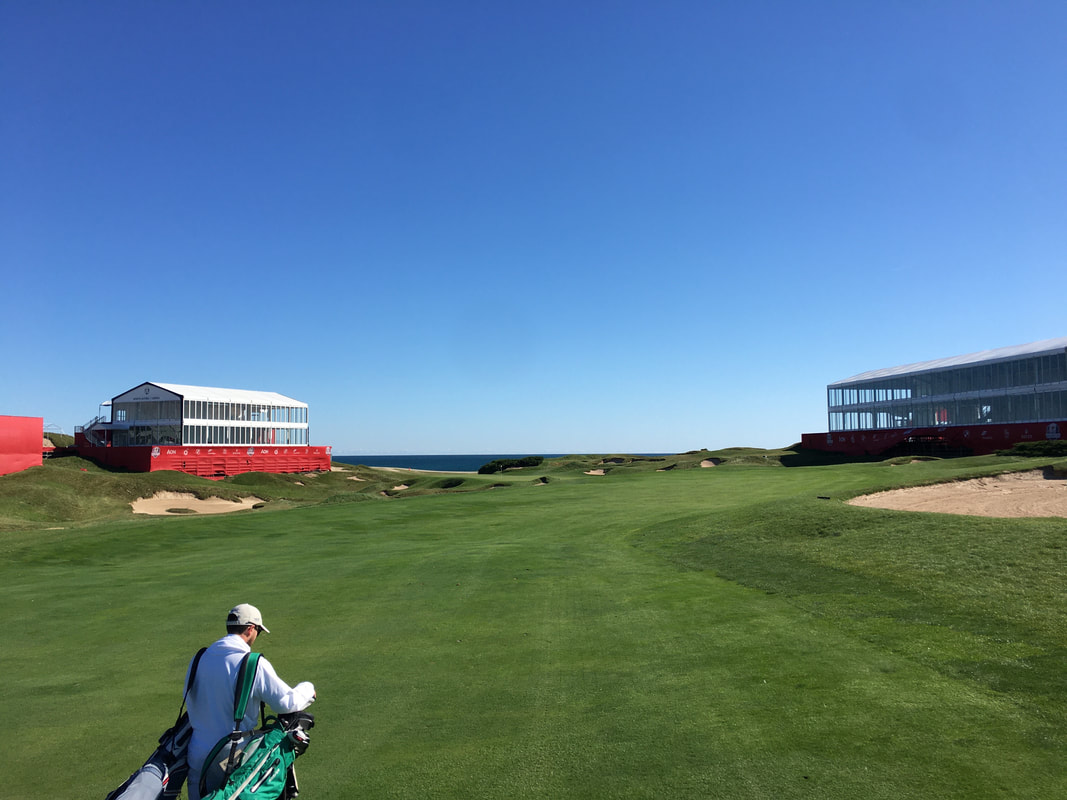





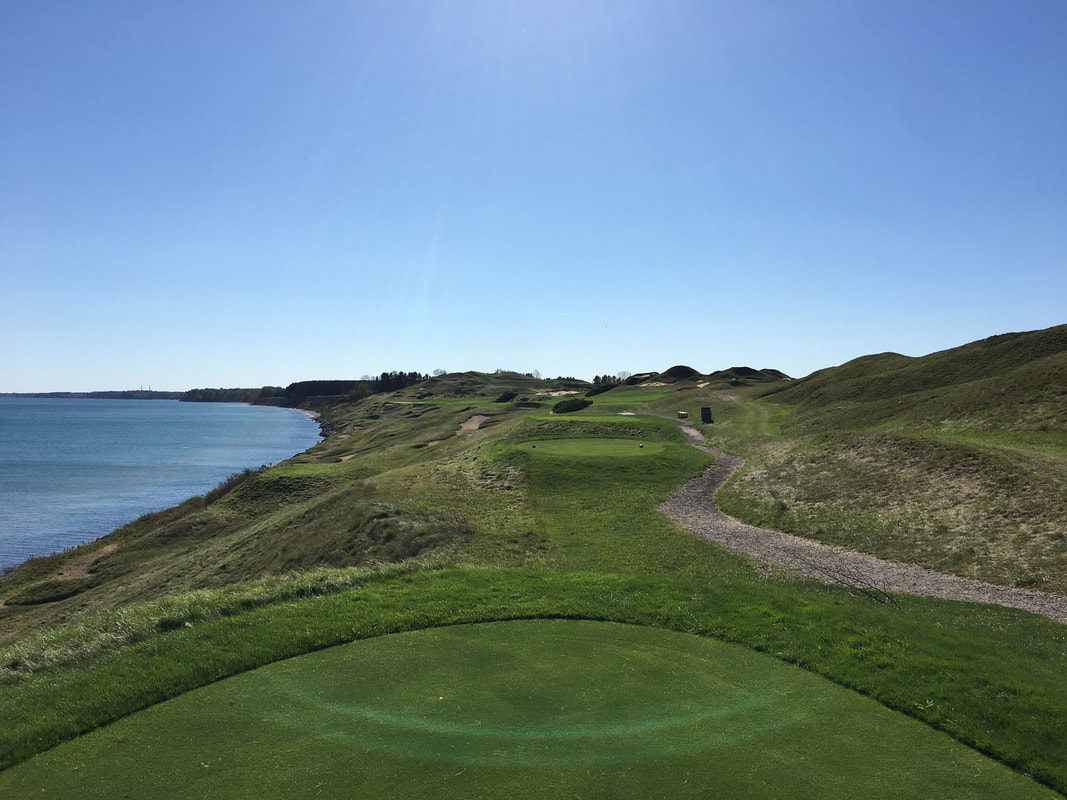


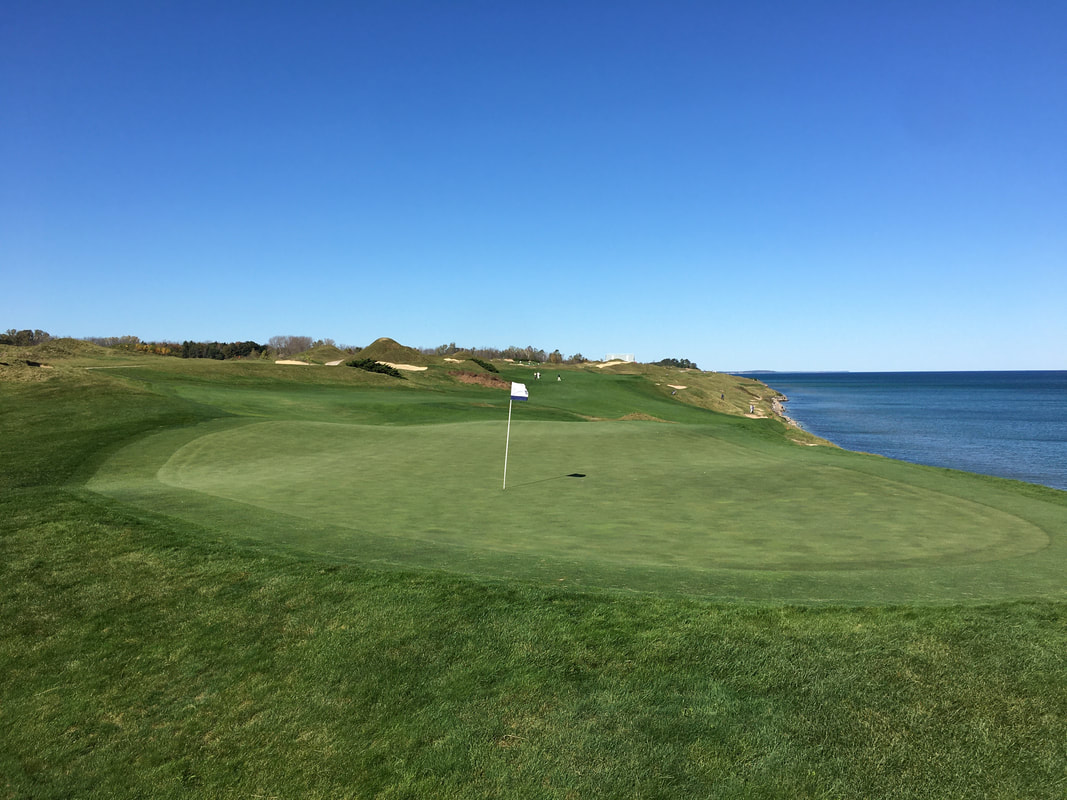










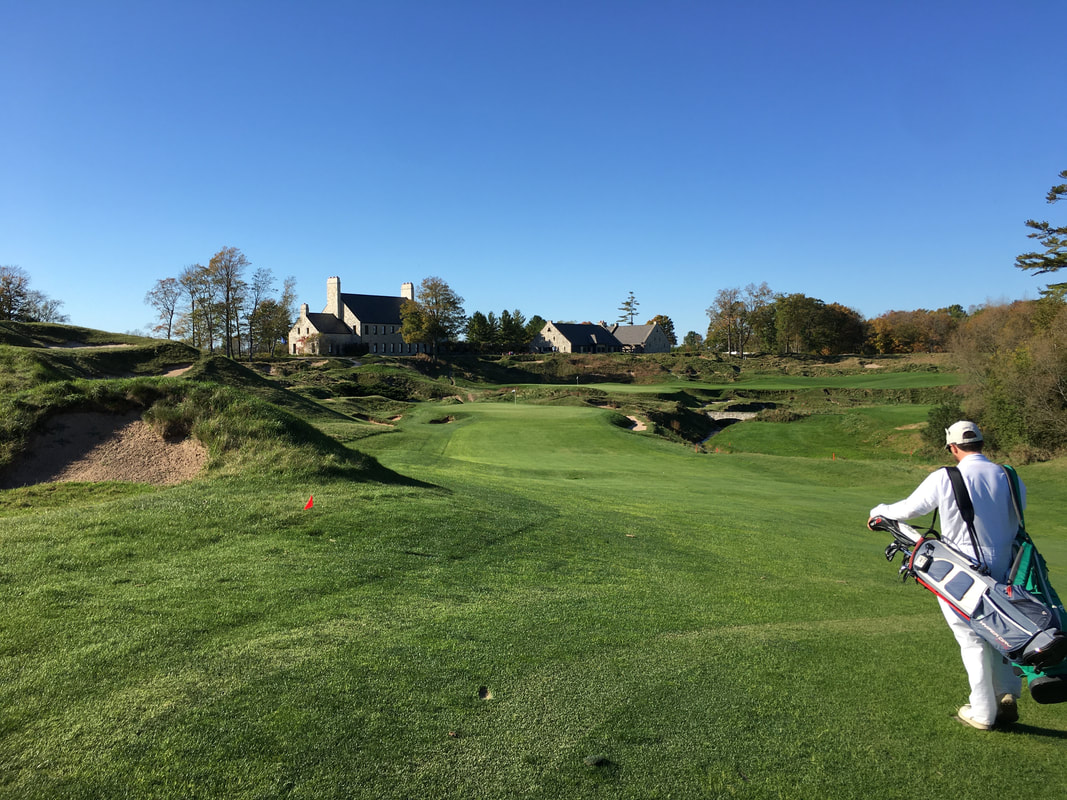


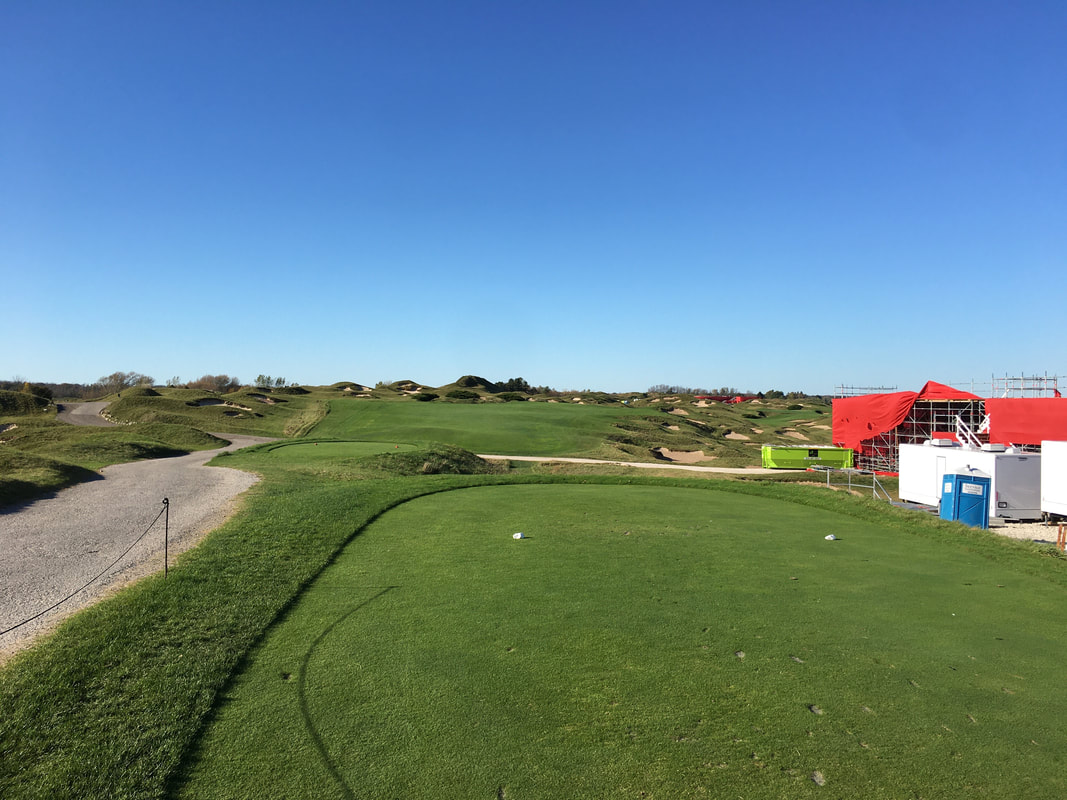
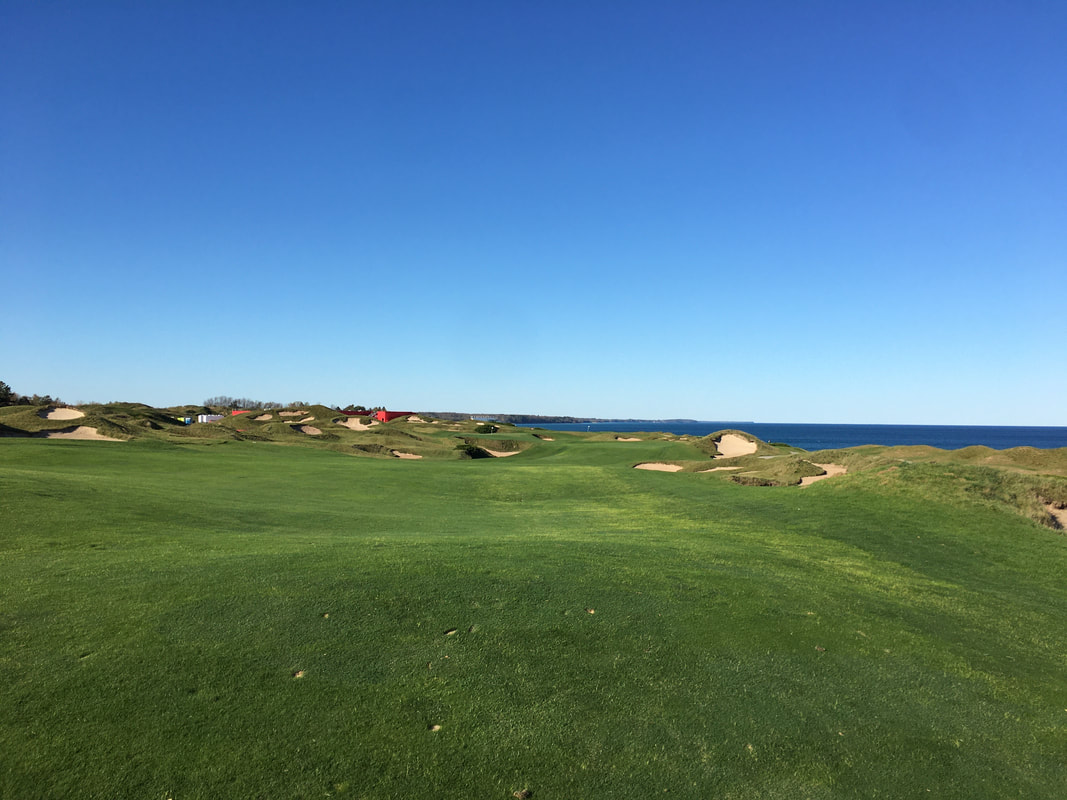


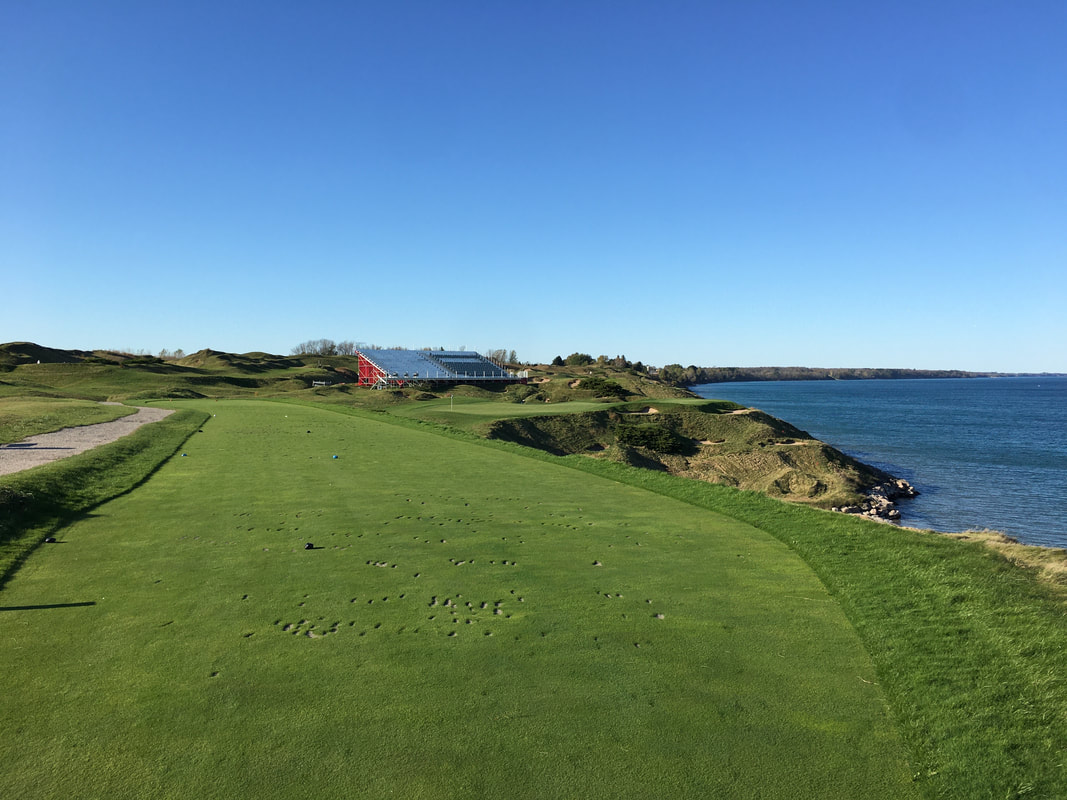













 RSS Feed
RSS Feed